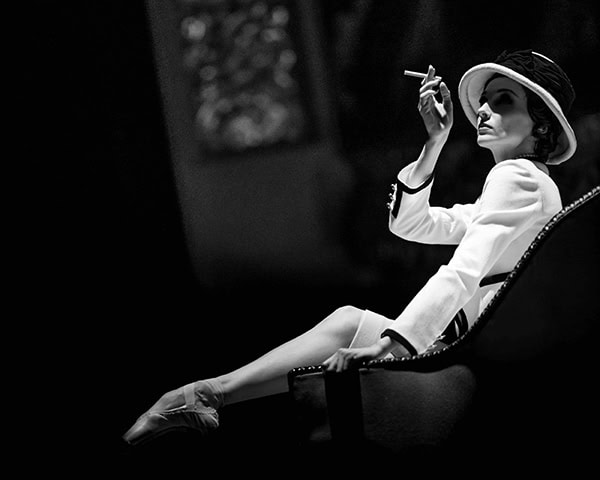Svetlana Zakharova in Modanse at the Coliseum
Posted: December 11th, 2019 | Author: Nicholas Minns | Filed under: Performance | Tags: Alexey Frandetti, Gabrielle Chanel, Galina Ulanova, Helena de Medeiros, Ilya Demutsky, Ilya Starilov, Jacopo Tissi, Maria Tregubova, Mauro Bigonzetti, Modanse, MuzArts, Svetlana Zakharova, Yuri Possokhov | Comments Off on Svetlana Zakharova in Modanse at the ColiseumSvetlana Zakharova in Modanse at the Coliseum, December 3

Svetlana Zakharova is the prima ballerina of the Bolshoi Ballet and the artistic director of MuzArts, the producer of this double bill, Modanse. The program includes two works — Mauro Bigonzetti’s Come Un Respiro (‘Like a Breath’) and Yuri Possokhov’s Gabrielle Chanel — in which Zakharova is the star accompanied by two male principals, two male leading soloists and fourteen artists of the Bolshoi Ballet.
For Zakharova to present herself in a context that focuses the spotlight uniquely on her talents is in keeping with a culture of celebrity. When the Bolshoi first came to London in 1956 its undisputed star was Galina Ulanova but her artistry was subsumed in the ballets in which she appeared — Romeo and Juliet, Swan Lake, The Fountain of Bakhchisarai and Giselle; by all accounts her identity was not separate from the roles she played. The current double bill turns this notion of the star inside out; in both works Zakharova appears as herself. Bigonzetti’s Come Un Respiro eschews character for an abstract study of articulate lines and shapes — both of which suit Zakharova’s outstanding plastic ability — and while Possokhov offers Zakharova the opportunity to inhabit the life of the iconic Chanel, she fails, by her own admission, to take it.
Come Un Respiro takes the breathless beauty of well-trained dancer’s bodies as the starting point of a physical puzzle that manipulates the classical lexicon into unconventional shapes and demonstrates, with a knowing sense of wit and playful eroticism, how such manipulations of the body affect its emotional expression. The program describes the work as ‘a modern reflection of the aesthetics of the Baroque period’; it rides on a recording of Handel’s Suites for Keyboard and is enhanced by the costumes of Helena de Medeiros. The men are bare chested in tights, and the women have stylish bodices with a baroque curlicue confection around their waists. Their arms and legs are laid bare like steely tendrils of an exotic plant with beautifully curved tips that can extend endlessly into languid shapes, hinge, cantilever or wrap themselves enticingly around their partners. Bigonzetti seems to love this show of sex more than he loves the pure pleasure of movement; his choreography too often manipulates shapes in place (with the exception of variations for Zakharova and Jacopo Tissi who refreshingly expand their shapes in space) that runs counter to the current of the keyboard suites. The effect of Come Un Respiro is overwhelmingly visual to the detriment of choreographic flow.
When she was researching the subject of Possokhov’s new ballet, Zakharova visited Chanel’s apartment at 30, rue de Cambon in Paris. She writes that it was not what she expected to find; the Byzantine luxury of the furnishings confused her. In looking for Chanel, ‘at some point I started to lose her’, she continues. ‘I tried to find at least some similarity, but the more I sank into her image, the clearer I realized that there was nothing in common between us. And that thought freed me, unchained me, and gave me the freedom to invent my own Chanel…’ For Zakharova and Possokhov it is apparently immaterial in the creation of Gabrielle Chanel that the central character is irredeemably conflated with the prima ballerina of the Bolshoi Ballet. There is no further need for biographical depth; Alexey Frandetti as librettist and director guides us through a timeline of events in Chanel’s early life that Possokhov uses as choreographic set pieces for his trio of principal characters: Chanel and two of her early, wealthy lovers, Étienne Balsan and the elegant Englishman, Arthur (Boy) Capel. While the Chanel-designed costumes are beautifully styled period reproductions, and Maria Tregubova’s sets and Ilya Starilov’s video projections make creative reference to contemporary taste, Ilya Demutsky’s score seems less concerned with finding flavours of French period music than in painting a contemporary portrait of the central character. Choreographically, Zhakarova’s two duets with Tissi as Boy Capel are the highlights but Possokhov tends to default to a traditional treatment of overwrought emotions. Boy Capel’s death in a car accident is perhaps the nadir of imagination, combining a grainy video projection of a car driving at speed along a narrow coastal road, stage lights momentarily blinding the driver (and audience) and a climax of Tissi performing a double tour to the ground not unlike Albrecht in Giselle. We do not learn very much in this sumptuous work about Chanel, but that is not its purpose; it’s about the legend, and as Chanel famously said, ‘Legend is the consecration of celebrity.’